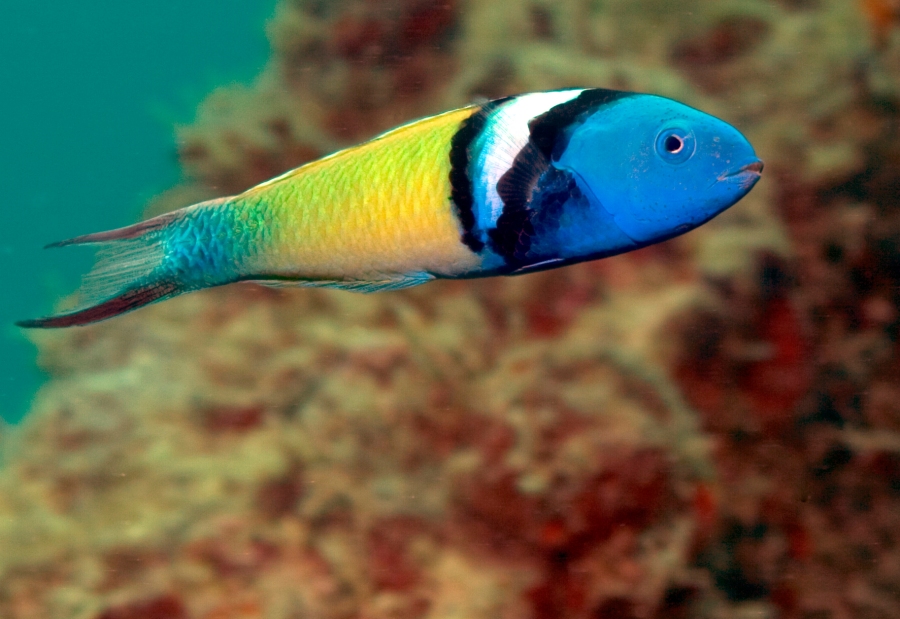BLUEHEAD WRASSE: PRIVATE LIFE LAID BARE
The bluehead wrasse (or blue-headed wrasse) Thalassoma bifasciatum is a denizen of the coral reefs in the tropical waters of the western Atlantic Ocean. This bright little 4-inch fish is… a wrasse with a blue head. No more and no less. Unless it’s a juvenile. Then it is mainly bright yellow. It’s similar to BLUE TANG (aka ‘the Disney Dory’), which starts life bright yellow and grows up to be blue.
The species may be found singly, in pairs or small groups, or in schools. They have an important role to play in the life of the reef. They are CLEANER FISH, vital to the health and wellbeing of the larger species they attend to, and thus of the reef itself. This is ‘cleaning symbiosis’, a relationship of mutual benefit. The big fish get cleaned; the little fish have a useful function and – importantly for them – therefore don’t get eaten.
Having said that, blueheads are of course fair game as a snack for species that aren’t in the market for their cleaning services. Rather unfairly, some species that are quite content to let cleaner gobies pick around their gills and mouths are not so considerate of the wrasse (some types of grouper and moray eel, for example).
TELL US EXACTLY SEVEN BLUEHEAD WRASSE FACTS
- Juveniles can alter the intensity of their colour, stripes & bars
- The bluehead wrasse is a ‘protogynous sequential hermaphrodite’
- All are born female**. Some change sex to male during maturation (see below)
- Food includes zooplankton, small molluscs and small crustaceans…
- …and parasites / other juicy bits (fungal growths, anyone?) from bigger fish
- Main threats to the species are coral reef degradation / destruction and pollution
- The bright colours invite aquarium use, but the trade in this species is not critical.
** Some sources suggest some are born male and remain male.
A juvenile bluehead – mostly yellow, with a pale underside

THE REMARKABLE SEX LIFE OF THE BLUEHEAD WRASSE
This is an unavoidable topic, I’m afraid. The bluehead’s sex life is the most interesting thing about them, and this is no time to be prudish. It has been the subject of extensive scientific research. As with many human relationships, “it’s complicated” but in a conch shell it boils down to this:
- To recap, BWs are born female and as they mature, some become male.
- Males reach an ‘initial phase’ when they can breed in groups with females
- Some males grow larger & reach full colouration. This is the ‘terminal phase’
- These large males aggressively chase away smaller ones & seek females to pair with
- Their state of readiness is signalled by colour changes BUT the females know…
- …that the smaller males have a sperm count higher than dominant males.
As the excellent organisation OCEANA puts it: Bluehead Wrasses may reproduce in four different ways throughout their lifetime: 1) as a female in a group spawning event; 2) as a female in a pair spawning event within the territory of a large male; 3) as a small male in a group spawning event; and 4) as a dominant, terminal male in a pair spawning event within its own territory.
A cropped still from a video I took at Fowl Cay marine reserve. I’ve looked at dozens of images online and not found one that was all blue with a yellow end to its tail fin. Perhaps it is just an all-blue alpha male.
Credits & Sources: Melinda Riger; Adam Rees; James St John; Oregon State edu / Pinterest; Wiki images; self; Oceana; IUCN; magpie pickings






Beautiful!
LikeLike